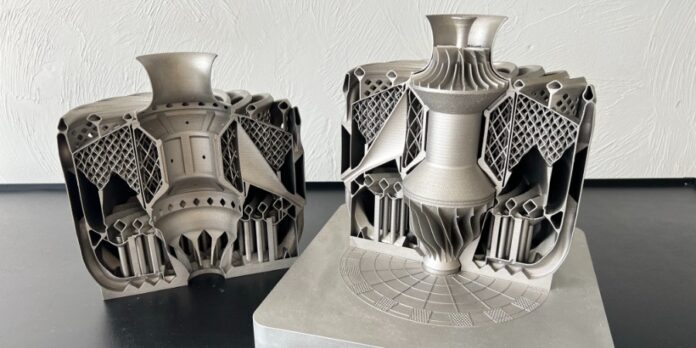Software company PTC has demonstrated the capabilities of DfAM by showcasing fully 3D-printed jet engine at its LiveWorx 2023 premier event. Designed in its Creo CAD software, the Inconel 3D printed jet engine weighs approximately eight pounds (3.6 kg); it is a single, complete assembly, including all rotating and stationary components.
Designing and printing a fully self-supported micro turbojet engine, including the 50,000 RPM turbine, that requires no assembly, represents a significant breakthrough in designing for additive manufacturing. PTC is rising from its own ashes today after a couple of years it spent advancing the core design capabilities of its Creo CAD software; capabilities that require the ability to transfer sophisticated designs directly to an AM environment. The result? An Inconel 3D printed jet engine, one of the most powerful and complex things to design out there, that requires to juggle between the performance requirements for operation and the intricacy of the components – many of which rotate or move in some way.
This proof point for additive manufacturing could have material impacts on the aerospace industry and how we think about manufacturing these kinds of micro turbojet engines. Today, these engines require complex assembly processes of many expensive parts, which puts customers directly in the crosshairs of supply chain dependencies, limited availability, and their manufacturers maintaining the right employee expertise to complete assemblies. With additive manufacturing, there is no assembly process, and there’s potential to substantially reduce the number of components used and tooling required for production. This brings down costs, reduces requirements down to a metal 3D printer, and opens the possibility of on-demand manufacturing directly at the customer site.
The jet engine project was conceived by Dr. Ronen Ben Horin, a VP of Technology at PTC and a Senior Research Fellow at Technion – Israel Institute of Technology and Beni Cukurel, an Associate Professor of Aerospace at Technion. The two brought together many years of deep scientific research in jet propulsion and engineering expertise in the design of advanced engines and designing for additive manufacturing.
When we spoke with Beni about the achievement, he acknowledged that it’s a rewarding accomplishment for him and Ronen, a culmination of many years of research while staying on top of advancements in the supporting technology. He’s pleased to see that their extensive knowledge and experience in jet propulsion could now result in a commercially viable way of producing these kinds of micro turbojet engines. He also credited Creo for being a powerful engineering system that’s capable of supporting their vision and this level of innovation, PTC explains.
Many of the Creo advanced design capabilities were used for the jet engine assembly, including:
- Lightweight Design: Creo enables sophisticated lattice modeling and generative design for material and weight reduction while maintaining the same strength and performance of designs with more material and heavier weight.
- Self-Supporting Geometries for 3D Printing: Beam-based lattices in Creo automatically optimize designs for printability. Creo also supports self-supported formula-driven lattices that can be paired with printability checks and modifiers to adjust the design for printing efficiency.
- 3D Printing Equipment Interoperability: Creo is compatible with most 3D printing equipment for printing and post-processing. The 3D component design in Creo is critical for performing traditional machining for precise assembly. Creo provides a variety of formats, including 3MF, for sending 3D models to the market’s various printer technologies, while also allowing users to easily create associative models for machining operations.
Remember, you can post job opportunities in the AM Industry on 3D ADEPT Media free of charge or look for a job via our job board. Make sure to follow us on our social networks and subscribe to our weekly newsletter : Facebook, Twitter, LinkedIn & Instagram ! If you want to be featured in the next issue of our digital magazine or if you hear a story that needs to be heard, make sure to send it to contact@3dadept.com


